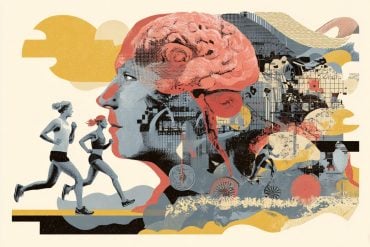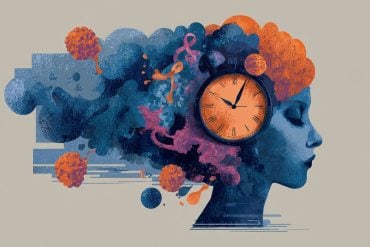Summary: A new study explores visual masking, a phenomenon where rapid sequential images lead to the first being ‘unseen.’
This study successfully demonstrated visual masking in mice, mirroring human perception, indicating a similar neurological process. By training mice to respond to visual stimuli, the researchers identified specific brain regions crucial for this illusion, shedding light on how conscious perception is formed.
The findings suggest that awareness generation may occur in the visual cortex or higher cortical areas.
Key Facts:
- Visual masking involves a failure to perceive an initial image when followed quickly by another, and this study proves it occurs in both humans and mice.
- The research identifies brain regions responsible for this phenomenon, suggesting conscious perception originates in the visual cortex or downstream cortical areas.
- The similarity in human and mouse perception of visual masking challenges our understanding of how conscious awareness is generated in the brain.
Source: Allen Institute
A new study out today in Nature Neuroscience on visual masking sheds light on how we unsee things and points to how conscious perception is generated in the brain.
In a phenomenon known as visual masking, individuals don’t consciously perceive an image if another image is shown in quick succession. But the timing of those images matters. The first image needs to flash on and off fairly quickly, and the second image needs to follow rapidly (on the order of 50 milliseconds) for the masking to work.
Shawn Olsen, Ph.D., an investigator at the Allen Institute, and his colleagues delved into the science behind this optical illusion and showed for the first time that it happens in mice too. After training mice to report on what they saw, the team was also able to pinpoint a certain region of the brain that’s necessary for the visual masking illusion to work.
“This is an interesting observation, where what is present in the world is not accurately reflected in your perception,” said Olsen. “Like other visual illusions, we think that it tells us something about the way the visual system works and ultimately about the neural circuits that underlie visual awareness.”
Scientists discovered this strange phenomenon in the 19th century, but why and how the human brain does this remains a mystery.
The study narrows down the parts of the brain responsible for awareness of the world around us, said Christof Koch, Ph.D., a meritorious investigator at the Allen Institute, who led the study along with Olsen and Sam Gale, Ph.D., a scientist at the Allen Institute.
When the rain of photons impinges on our retinas, the information takes a prescribed path from our eyeballs through several different regions of the brain, ending in higher processing areas of the cortex, the wrinkled outermost shell of the brain.
From previous studies of visual masking, scientists know that neurons in the retina and parts of the brain early in that pathway are activated even when a person is not aware that they’re seeing an image. In other words, your brain is seeing things without your knowledge.
To explore where unconscious sensation turns into conscious perception and action, the scientists first trained 16 mice to turn a tiny LEGO wheel toward the direction of a quickly flashed image in exchange for a treat if they chose the correct direction.
The scientists then added a different masking image on both sides of the screen, directly following the target image. With the addition of the mask, the animals could no longer do the task correctly—implying they were no longer aware of the original, target image.
Because visual masking had never been tested in mice before, the research team had to create the task for them, meaning the images and how they were shown differed from those used in previous human studies.
To confirm that the optical illusion they showed the rodents is relevant to us, the team also tested it in 16 people (the wheel replaced by keystroke). Human perception (or lack thereof) and mouse perception of this specific visual masking illusion turned out to be very similar.
That result means that conscious perception is happening either in the visual cortex or in higher areas of the cortex downstream of it. That fits with the general sentiment in the field that the cortex is the seat of conscious perception in mammals, including us, Koch said.
About this visual neuroscience research news
Author: Peter Kim
Source: Allen Institute
Contact: Peter Kim – Allen Institute
Image: The image is credited to Neuroscience News
Original Research: Closed access.
“Backward masking in mice requires visual cortex” by Shawn Olsen et al. Nature Neuroscience
Abstract
Backward masking in mice requires visual cortex
Visual masking can reveal the timescale of perception, but the underlying circuit mechanisms are not understood.
Here we describe a backward masking task in mice and humans in which the location of a stimulus is potently masked.
Humans report reduced subjective visibility that tracks behavioral deficits. In mice, both masking and optogenetic silencing of visual cortex (V1) reduce performance over a similar timecourse but have distinct effects on response rates and accuracy.
Activity in V1 is consistent with masked behavior when quantified over long, but not short, time windows. A dual accumulator model recapitulates both mouse and human behavior.
The model and subjects’ performance imply that the initial spikes in V1 can trigger a correct response, but subsequent V1 activity degrades performance. Supporting this hypothesis, optogenetically suppressing mask-evoked activity in V1 fully restores accurate behavior.
Together, these results demonstrate that mice, like humans, are susceptible to masking and that target and mask information is first confounded downstream of V1.








